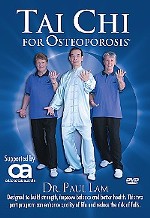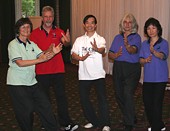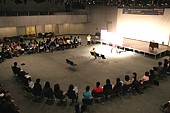Tai Chi for Osteoporosis
By: Dr Paul Lam
Tai Chi for Osteoporosis is designed based on available medical evidence by a team of medical and tai chi experts Published in the Summer 2005 issue as a feature article of the “Osteoblast” the official magazine of Osteoporosis Australia. Click here for information of the instructional DVD of the same title.
Dr Paul Lam. All rights reserved except copying for educational, non profit purpose. For example you can copy this article for your fee paying students and conference attendants provided fee is not charged for this article.

Synopsis
Tai chi is an increasingly popular exercise because it is enjoyable and beneficial for health. Suitable exercise is an important part of the treatment for people with osteoporosis.
Tai chi works by slowing down bone loss, improving balance, reducing falls, and improving quality of life. A specially designed tai chi program has advantages in terms of safety and efficacy.
What is Tai Chi?
“Tai chi is sometimes described as ‘meditation in motion.’ … Purported health benefits include increased flexibility, greater balance and reduced stress” Mayoclinic.com
There are numerous forms of tai chi, each with significant differences in terms of physical exertion, appearance and training methods. For example, the original tai chi – Chen style – is vigorous. It includes jumping in the air, stomping heavily on the ground, kicking and punching. This style is not suitable for people with osteoporosis.
The majorities of tai chi styles, however, are slow and gentle and can be suitable for people with osteoporosis. Tai chi movements are fluid and graceful, although they can be difficult to learn, for example, the most popular Yang style has a set of 108 forms that can take an average student two years to complete. Well-modified forms for health benefits are safer and easier to learn.

Choosing an exercise
Osteoporosis mostly affects older people who often suffer from other medical problems. An exercise that can improve not only osteoporosis but also any other medical conditions should be considered. It is also important to enjoy the exercise otherwise it won’t be adhered to. Questions such as ‘Do I like the exercise?’ ‘Is it helping me as a person?’, ‘Does it help me to relax?’, ‘Does it improve my ability to do my daily activities?’, “Has my pain decreased since exercising?’ should be considered.
How Does It Work for Osteoporosis?
There are many ways that tai chi works well for people with osteoporosis and other conditions. Listed below are the important factors supported by medical studies.

Bone Loss
An excellent study showed tai chi slowed down the loss of bone mineral density approximately three fold. Another study indicated that people who practice tai chi regularly have higher bone mineral density and better flexibility, muscle strength and balance.
Fall Prevention
Many studies have shown that tai chi reduces falls. This is especially important because when people with osteoporosis fall they are more like to sustain a fracture. A fracture can be a very serious problem for example hip fractures have a mortality rate of approximately 50%. It also seriously affects your quality of life. Tai chi has also been shown to improve balance and strength so even if you fall, you have a lesser chance of serious injury.
Associated Conditions
People with osteoporosis often have arthritis, loss of function due to age and weakness. Studies have shown that tai chi relieves pain from arthritis, improves balance and the ability to do daily activities.
Stress
People with chronic conditions such as osteoporosis are more likely to be mentally stressed and depressed because of the increasing inability to function normally on a day-to-day basis. Tai Chi has been shown to improve the mind, help people feel more relaxed and improve mental strength so they can cope better with chronic diseases.

How to Try Tai Chi
It is important to know a little bit about tai chi and to understand that it is a very different exercise from what we are used to in the western world. We are used to exercise being fast and strong whereas tai chi emphasises the balance of nature so hardness and softness are balanced. Tai chi works through internal strengthening, which means that the internal organs, deep or core muscles and the mind are strengthened. Therefore physical exertion is minimised so that there is less risk of injury. In tai chi you are required to move slowly, to be aware of your body and use your mind to control your movements. Tai chi works on the ancient Chinese understanding of nature in that a movement usually travels in a curve or takes a circular path instead of a straight line as we are used to.
Getting accustomed to the speed, the control, the mind components and moving circular rather than straight, may take a little time. We have found that most of our students take about three months to get over that feeling of clumsiness and then they begin to enjoy their tai chi. In most of our scientific studies, we have found that if we can keep students interested for more than six months, they tend to adhere to tai chi for life, that is almost addictive!
The Advantage of a Modified Program
Tai chi was originally a complex martial art. Its training method was very strict and physically demanding, nowadays most people use tai chi for its health benefits. With the change of focus, the art would serve people better if modified for the purpose. Most research studies on tai chi are based on modified forms. The ideal way to compose a designed program should include health professionals in the respective field and tai chi experts of different styles.
I have worked with a group of health professionals please contact us for the instructional DVD of the program, or Osteoporosis Australia, Arthritis foundation in Australia or us for information about classes.
NB: References are available on request; please contact the author.
